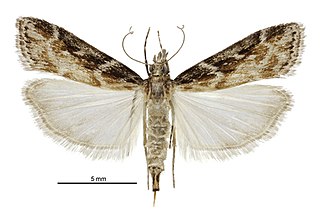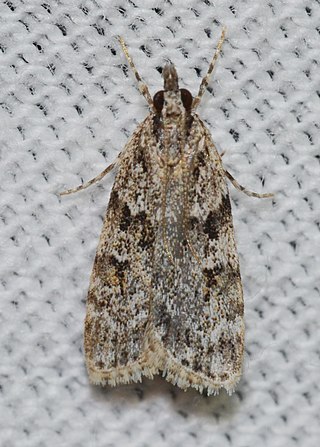
Elaphria venustula is a moth of the family Noctuidae. It is found in most of Europe, except the north. In the east, the range extends through the Palearctic to the Pacific Ocean.

Scoparia molifera, also known as the leather-leaf Scoparia, is a species of moth of the family Crambidae. This species was first described by Edward Meyrick in 1926 and is endemic to New Zealand. It can be found in the North and South Islands. The larvae of this species make silk tunnels from which they mine the leaves of their host, the leather-leaf fern Pyrrosia eleagnifolia. Adult moths are on wing from December to February and are attracted to light.
Eudonia extincta is a moth in the family Crambidae. It was described by Harrison Gray Dyar Jr. in 1921. It is found in the Distrito Federal of Mexico.
Eudonia excursalis is a moth in the family Crambidae. It was described by Harrison Gray Dyar Jr. in 1929. It is found in Costa Rica.
Eudonia inexoptata is a moth in the family Crambidae. It was described by Harrison Gray Dyar Jr. in 1929. It is found in Mexico.
Eudonia vinasalis is a moth in the family Crambidae. It was described by Harrison Gray Dyar Jr. in 1929. It is found in Costa Rica.
Eudonia ycarda is a moth in the family Crambidae. It was described by Harrison Gray Dyar Jr. in 1929. It is found in Guatemala and Orizaba, Mexico.
Eudonia schwarzalis is a moth in the family Crambidae. It was described by Harrison Gray Dyar Jr. in 1906. It is found in North America, where it has been recorded from Arizona.
Scoparia anadonta is a moth in the family Crambidae. It was described by Harrison Gray Dyar Jr. in 1918. It is found in Hidalgo, Mexico.

Scoparia biplagialis, the double-striped scoparia moth, is a moth in the family Crambidae. It was described by Francis Walker in 1866. It is found in North America, where it has been recorded from Alabama, Alaska, Alberta, British Columbia, California, Colorado, Florida, Georgia, Illinois, Indiana, Kentucky, Maine, Manitoba, Maryland, Massachusetts, Michigan, Minnesota, Montana, New Brunswick, New Hampshire, New Jersey, New York, North Carolina, North Dakota, Nova Scotia, Ohio, Ontario, Oregon, Pennsylvania, Quebec, Tennessee, Virginia, Washington, West Virginia and Wisconsin.
Scoparia cinereomedia is a moth in the family Crambidae. It was described by Harrison Gray Dyar Jr. in 1904. It is found in North America, where it has been recorded from British Columbia, Kentucky, Maine, Manitoba, Maryland, New Brunswick, New Hampshire, North Carolina, Nova Scotia, Ohio, Ontario, Quebec, South Carolina, Tennessee, Virginia and West Virginia.
Scoparia denigata is a moth in the family Crambidae. It was described by Harrison Gray Dyar Jr. in 1929. It has been recorded from the US state of Arizona.
Scoparia jonesalis is a moth in the family Crambidae. It was described by Harrison Gray Dyar Jr. in 1915. It is found on the Bermuda Islands.
Scoparia multifacies is a moth in the family Crambidae. It was described by Harrison Gray Dyar Jr. in 1929. It is found in Guatemala and Xalapa, Mexico.
Scoparia rigidalis is a moth in the family Crambidae. It was described by William Barnes and James Halliday McDunnough in 1912. It is found in North America, where it has been recorded from Arizona.
Scoparia subtersa is a moth in the family Crambidae. It was described by Harrison Gray Dyar Jr. in 1929. It is found in Guatemala, Costa Rica, Mexico and Trinidad.
Scoparia ulmaya is a moth in the family Crambidae. It was described by Harrison Gray Dyar Jr. in 1929. It is found on the West Indies, where it has been recorded from Guadeloupe.
Choristostigma particolor is a moth in the family Crambidae. It was described by Harrison Gray Dyar Jr. in 1914. It is found in Zacualpan, Mexico.
Boryzops purissima is a species of moth of the family Erebidae. It is found in the southern United States, where it has been recorded from Florida and Texas, as well as in Veracruz in Mexico, Costa Rica and Jamaica.
Sufetula hypocharopa is a moth in the family Crambidae. It was described by Harrison Gray Dyar Jr. in 1914, and, is found in Panama.


